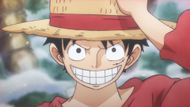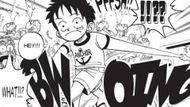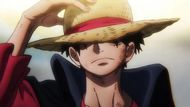For more than 25 years, One Piece has been a series where every detail feels intentional, no matter how small. From background Easter eggs to cryptic dialogue, Eiichiro Oda has built a narrative where hidden meanings and foreshadowing constantly fuel speculation.
One of the more surprising places fans have turned their attention to is the One Piece logo itself. At first glance, the logo simply represents Luffy’s Jolly Roger. But some fans argue that this logo might not just be a cool piece of branding.
Instead, it could symbolize something much deeper: the line of succession from JoyBoy, the first pirate, to Monkey D. Luffy, the destined inheritor of his will. The theory first gained traction in fan communities when readers noticed how well recent lore reveals about JoyBoy retroactively fit into the logo’s imagery.

We now know that JoyBoy wasn’t just a legendary figure from the Void Century; he was also the original pirate who raised the very first Jolly Roger and wore the first great straw hat.
If that’s true, then what we’ve always assumed to be Luffy’s Jolly Roger in the logo might actually be JoyBoy’s. The rope running through the letters of “One Piece” could then represent the continuity of will, tying JoyBoy’s legacy to future generations.
At the far end of the logo sits a stylized anchor sign, something many fans brushed off as a simple decoration. But the theory suggests this anchor is more than a design flourish. It could symbolize Luffy himself, the final inheritor who “anchors” JoyBoy’s dream in reality.
Luffy’s anchor connection in One Piece

This anchor connection becomes even more compelling when you remember Luffy’s very first appearance in Chapter 1. Before we knew anything about him, Luffy was introduced as a little boy wearing an anchor shirt. At the time, it seemed like an arbitrary clothing choice. But in hindsight, it looks suspiciously like Oda’s foreshadowing.
If JoyBoy is the skull in the logo and the rope is the line of succession, then Luffy being tied to the anchor symbol makes perfect sense. He is the one destined to ground JoyBoy’s will and bring it back to the world, much like how an anchor grounds a ship to a location.
Fans on forums have taken this further by pointing out that “Shanks” could even be a symbolic name, derived from the shank of an anchor, positioning him as a bridge between JoyBoy’s era and Luffy’s.
Shanks' passing on Roger’s straw hat to Luffy might have been more than sentiment; it could have been the deliberate act of ensuring the chain of succession stayed intact.
Could it be a coincidence?

Of course, there’s always a counterpoint. In a behind-the-scenes interview, it was revealed that Oda himself did not design the One Piece logo. Instead, a Jump employee at the time created it as part of the magazine’s branding.
This raises the possibility that all these interpretations are simply coincidences that fans are projecting meaning onto something never meant to hold any. But if One Piece has taught us anything, it’s that coincidences rarely stay coincidences.
Even if Oda wasn’t directly involved in the logo’s creation, it wouldn’t be unlike him to retroactively weave it into the story. He has done this countless times before, pulling details from early chapters into major late-game revelations. The logo could have started as marketing, but became symbolic through story, later on.
Final thoughts
So, could the One Piece logo be hiding the line from JoyBoy to Luffy? The answer depends on how much weight you give to symbolic interpretation versus concrete facts. On one hand, it may simply be a marketing design, with no deeper intention.
On the other hand, its imagery fits so perfectly with the themes of inheritance, anchors, and continuity that dismissing it outright feels almost naive. If true, then every chapter of One Piece has been teasing us with the story’s ending right from the beginning.
